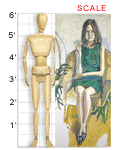From the collection of:
The Speed Art Museum || VAM Home
Alice Neel (American, 1900-1984)
PRISCILLA JOHNSON, 1966
Oil on canvas; 70" X 30"
Purchased with funds from the New Collectors and the National Endowment for the Arts, 80.14
The Speed Art Museum
This portrait is a full-length depiction of an ordinary young woman, an acquaintance of artist Alice Neel. As with many portraits, we can determine a good deal about the sitter by observing the style of her hair, clothing, and furniture. For instance, the woman’s short skirt and hairstyle were both popular fashion features in the 1960s.
Yet Priscilla Johnson is also more than a picture of a particular person in a particular place. The artist has exaggerated and highlighted certain features and details within the painting to express emotional meaning. The sitter’s long, narrow limbs and fingers, her stiff posture and wide staring eyes, and the dramatic contrasts of light and shadow all suggest what the subject might be feeling. This expressive approach toward art attempts to convey the artist’s personal emotional response to the subject. Artists who work with an expressive approach often employ exaggeration, harsh contrasts, and vivid color to make an emotional impact.
About the Artist
American artist Alice Neel bucked many of the art trends of her time. She painted figurative pieces (depicting people) at a time when many artists worked in an abstract, non-representational manner. Her work was influenced by her concern for the welfare of ordinary city people. It was only when interest in realistic art was rekindled in the 1970s that Neel’s work received widespread attention.
Neel was born in suburban Philadelphia and graduated from the Philadelphia School of Design for Women (now the Moore College of Art and Design) in 1925. She married a Cuban artist and spent a year in Havana before returning to America, spending the rest of her life in New York City.
“I don’t know if the truth that I have told will benefit the world in any way.... But at least I tried to reflect innocently the 20th century and my feelings and perceptions as a girl and a woman.”
Although she occasionally painted landscapes, people were her primary subjects. She disliked the term portrait (saying that it implies hack work), but she did not depict anonymous models. Her figures were always specific. From young girls in Harlem to celebrities such as Andy Warhol, her subjects included the people of her time and place, depicted with compassion and freedom; her paintings could be both tender and unforgiving at the same time.
Neel called herself a “collector of souls.” Toward the end of her life, she summed it up this way: “I don’t know if the truth that I have told will benefit the world in any way. I managed to do it at great cost to myself and perhaps to others. It is hard to go against the tide of one’s time, milieu, and position. But at least I tried to reflect innocently the 20th century and my feelings and perceptions as a girl and a woman—not that I felt that they were all that different from men’s. I did this at the expense of untold humiliations, but at least after my fashion I told the truth as I perceived it and, considering the way one is bombarded by reality, did the best and most honest art of which I was capable.”
Classroom Ideas
Discussion: Do a visual inventory of the painting. What does this painting tell you about Priscilla Johnson? Does she look happy? What body features are exaggerated? What clues tell you the decade in which this picture was painted? What color scheme is used? What do you think the artist thought of Priscilla? Watch the video segment of artist Ann Tower discussing this painting on Responding to Visual Art. How does her reaction compare to yours?
Compare this portrait to others, especially earlier portraits. What makes them similar or different from one another? Consider how the different painting styles and approaches affect the impacts of the respective portraits.
View other works by Alice Neel and think about her quote. Do her artworks reflect her stated concerns? Do you think that Neel was “telling the truth” about the people she painted? Do her subjects seem more real or less real because of the expressiveness and distortion she uses?
Activities: Look at a variety of portraits by Neel and others and try to determine when they were painted by the clothing and other details. Paint a portrait of a relative or classmate, using details that would tell a viewer it was painted in the early 21st century.
Write a story about Priscilla Johnson inspired by her portrait. Who is she? How old is she? Where does she come from? Is she married or single? Why is her pose so tense? Use your imagination to develop a story about this young woman.
Links
Background information about Alice Neel and more ideas for discussing this work are available on the Speed Art Museum’s Four Contemporary Women Artists page.
[www.speedmuseum.org/contemporary.html]
Look up links to Alice Neel works online in the Artcyclopedia.
[www.artcyclopedia.com/artists/neel_alice.html]

